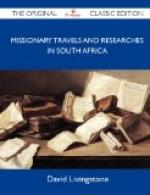We parted on the best possible terms with our friend Shinte, and proceeded by our former path to the village of his sister Nyamoana, who is now a widow. She received us with much apparent feeling, and said, “We had removed from our former abode to the place where you found us, and had no idea then that it was the spot where my husband was to die.” She had come to the River Lofuje, as they never remain in a place where death has once visited them. We received the loan of five small canoes from her, and also one of those we had left here before, to proceed down the Leeba. After viewing the Coanza at Massangano, I thought the Leeba at least a third larger, and upward of two hundred yards wide. We saw evidence of its rise during its last flood having been upward of forty feet in perpendicular height; but this is probably more than usual, as the amount of rain was above the average. My companions purchased also a number of canoes from the Balonda. These are very small, and can carry only two persons. They are made quite thin and light, and as sharp as racing-skiffs, because they are used in hunting animals in the water. The price paid was a string of beads equal to the length of the canoe. We advised them to bring canoes for sale to the Makololo, as they would gladly give them cows in exchange.
In descending the Leeba we saw many herds of wild animals, especially the tahetsi (’Aigoceros equina’), one magnificent antelope, the putokuane (’Antilope niger’), and two fine lions. The Balobale, however, are getting well supplied with guns, and will soon thin out the large game. At one of the villages we were entreated to attack some buffaloes which grazed in the gardens every night and destroyed the manioc. As we had had no success in shooting at the game we had seen, and we all longed to have a meal of meat, we followed the footprints of a number of old bulls. They showed a great amount of cunning by selecting the densest parts of very closely-planted forests to stand or recline in during the day. We came within six yards of them several times before we knew that they were so near. We only heard them rush away among the crashing branches, catching only a glimpse of them. It was somewhat exciting to feel, as we trod on the dry leaves with stealthy steps, that, for any thing we knew, we might next moment be charged by one of the most dangerous beasts of the forest. We threaded out their doublings for hours, drawn on by a keen craving for animal food, as we had been entirely without salt for upward of two months, but never could get a shot.




